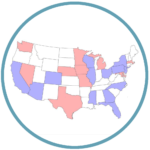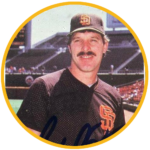Dale Long, known for other home run feats, was tantalizingly close to v-Club immortality

The Mahatma’s (South)Paw
Dale Long made his major league debut with the Pirates in 1951. He was coming off a seven-year stretch of instability where he moved from team to team in the minors which had culminated with an impressive 27 home run, 130 RBI year in Binghamton which did not capture the attention of the Yankees.
So it was off to Pittsburgh, then owned by a looming specter of the v16 Club, Branch Rickey. Rickey saw something in Dale Long and that something included a weak-fielding first baseman and outfielder. The solution was obvious! Why not make him a catcher? Perhaps that makes sense until you learn that Long was a left-hand thrower. In the history of the National and American Leagues, there have been fewer than twenty left-hand throwing catchers and all but one saw no appreciable time behind the plate. And perhaps also note that Long never played at catcher while with the Pirates, but he would later play two games at catcher with the Cubs.
Not only did Long not take the field as a catcher while with the Pirates, he didn’t take the field at all, save for one game – a productive appearance starting at first base:
LEDGER ONE: May 5, 1951 at New York Giants
Branch Rickey ended Long’s time with the Buccos via waiver only five plate appearances later. Long was picked up by the St. Louis Browns and finished up an unremarkable season with two more home runs, both against the Athletics, before being sent down to the minors.
LEDGER TWO: June 23, 1951 at Philadelphia Athletics
And the minors is where Long would stay for three full seasons before having his career plucked off the pile of baseball obscurity by the Pirates yet again.
The Successor, Literally.
Long went into the 1955 season as the backup for a player who would become very familiar to the v16 Club. Preston Ward, a fellow south-central Missouri-born player, was penciled in as the Pirates every day first baseman but was soon usurped by Long who exhibited a sudden burst of pop – 16 home runs and a league leading 13 triples by the time the season ended. This power brought with it a maxed out ledger.
LEDGER THREE: May 15, 1955 at St. Louis Cardinals
LEDGER FOUR: May 30, 1955 (Game 1) at Brooklyn Dodgers
LEDGER FIVE: June 8, 1955 vs Chicago Cubs
LEDGER SIX: June 19, 1955 (Game 1) at Cincinnati Reds
LEDGER SEVEN: June 28, 1955 at Philadelphia Phillies
LEDGER EIGHT: August 6, 1955 at Milwaukee Braves
Long collected MVP votes for his 1955 performance and had seemingly cemented himself as a feared hitter.
Ain’t Got Nothing but Bombs, Babe; Eight Games, A Streak
While inconsequential from a v-Club perspective, 1956 still had something in store for the record books. Long’s home runs weren’t just barely scraping by. Many of his home runs were mammoth blasts, some saying the longest in Forbes Field history. Then with six home runs already to his credit on the season, Long stepped in against the Cubs Jim Davis and smacked a two-run homer on May 19th. Long homered on May 20 in the first game of a doubleheader with the Braves and then again in the second game of the twin bill. He then hit one in each game of a two game series against the Cardinals. The Bucs traveled to Philadelphia and Long homered in both games of that series. Then they came home to see Long hit one more on May 28 against the Dodgers. Long had homered in eight consecutive games – a record he holds to this day (along with Don Mattingly and Ken Griffey Jr.).
The streak had made him a minor celebrity, both locally and nationally. Then, like other v-Club prospects before him, Long got injured and his production dipped. Two All-Star caliber seasons were not enough to spare Long and he was traded to the Cubs early in the 1957 season for Dee Fondy, another minor character from the Preston Ward profile.
LEDGER NINE: May 14, 1957 vs Pittsburgh Pirates
Long had stints of power with the Cubs for two seasons, but his overall production (and some claim attitude) was lacking. He did what he needed to do against his former team, but was shipped to San Francisco just prior to the start of the 1960 season.
The Successor, Spiritually.
In August 1960, Long was on the move again, this time being purchased by the Yankees. If Long had anything left in the tank now was his chance to tally some ledgers. In just over a month of action, he managed three.
LEDGER TEN: May 14, 1960 (Game 2) vs Detroit Tigers
LEDGER ELEVEN: September 26, 1960 at Washington Senators (the original)
LEDGER TWELVE: October 2, 1960 vs Boston Red Sox
Preston Ward, who Long had displaced in Pittsburgh, joined the v16 Club two seasons earlier. Could Dale Long be the next to join?
The Washington Senators (No, not those Washington Senators)
As 1961 dawned on baseball one saw the American League positively scrambling to add two more teams in the wake of movement from the National League to do the same which was in reaction to the formulation of the Continental League (read more!). All American League teams had to offer up a handful of players for the expansion draft and Long was among those available from the Yankees. He was selected with the draft’s 28th pick with the hopes of adding power to the new Washington Senators lineup.
Upon first pitch of 1961 the the v16 Club officially closed and in its place was introduced the v18 Club. Players now had to hit a home runs against the “original” sixteen teams plus the new Senators and Los Angeles Angels. The three previous inductees had all retired by 1961, so a player was going to have to capture at least three ledgers to join and would likely need to play in the American League.
Dale Long maintained some power throughout the season, enough to capture five ledgers.
LEDGER THIRTEEN: May 21, 1961 (Game 2) at Los Angeles Angels
LEDGER FOURTEEN: June 9, 1961 (Game 2) vs Chicago White Sox
LEDGER FIFTEEN: June 15, 1961 at Baltimore Orioles
LEDGER SIXTEEN: June 27, 1961 at Cleveland Indians
And with his last ledger of the season, Dale Long became the first MLB player to hit a home run against seventeen unique opponents.
LEDGER SEVENTEEN: July 1, 1961 at New York Yankees
Here was the rub. Long was now maxed out. He needed the new Senators and he was playing with the new Seantors. The v18 Club seemingly wasn’t in the cards since it was known that the Mets and Colt .45s would be joining the National League in 1962 which would institute the v20 Club after only a single season of the v18.
The Fate of the Malcontent
But what might have been is fascinating. Long’s relationship with the Senators was less than comfortable. Some of the same attributes that dogged him in Chicago and Pittsburgh popped up in Washington – he didn’t try his hardest, he was a distraction, he wasn’t good for his team. By mid-1961 it was speculated he would be traded back to the Yankees.
In those days the trade deadline was in mid-June. You’ll notice he hit his ledger against the Yankees on July 1. So a move back to the Yankees at the deadline would have also left him maxed out in all likelihood. But if Long somehow made his way back to the Yankees after July 1 he would have had eleven games against the Senators and would have quite possibly become the sole member of the v18 Club.
Turns out Long eventually did make his way back to the Yankees, but it was mid-1962. With that move, Long also became the first player to hit a home run against eighteen unique opponents.
LEDGER EIGHTEEN: July 22, 1962 (Game 2) vs Washington Senators
And that was effectively the end of his career. He didn’t make his way back to the National League for a shot at v20, ending instead with a handful of games with the Yankees in 1963.
Long stands as the honorary v18 Club representative1, encapsulating a turbulent time where MLB was growing for the first time in nearly sixty years. He was another player who fit the v-Club mold – often struggling to find his home, having periods of great production and periods of famine or injury, and persevering through the adversity.
REFERENCES AND SOURCES: Dale Long – Society for American Baseball Research
Appendix – Facts and Figures of the v18 Season
Only thirty-four batters homered against both the Angels and new Senators in 1961, making the pool of v18 candidates even smaller.
Of those 34 players, Willie Kirkland finished 1961 with the most ledgers (16). He was only missing the Giants (who he played for exclusively while in the National League) and the Indians (who he played with in 1961).
Steve Bilko would be next in line. Bilko had a striking similar career ledger progression to Long’s, hitting four ledger home runs in 1961 (which were numbers 14 through 17) while playing for the expansion Angels. Bilko retired with the Angels in 1962 never reaching eighteen ledgers.

